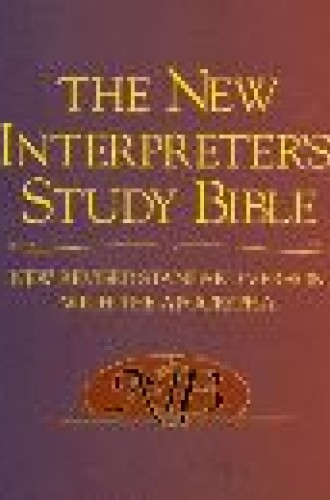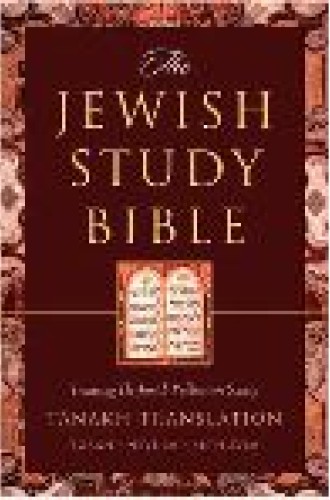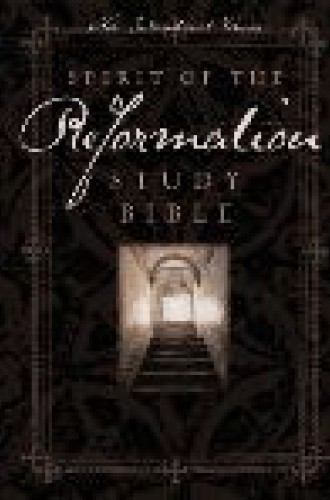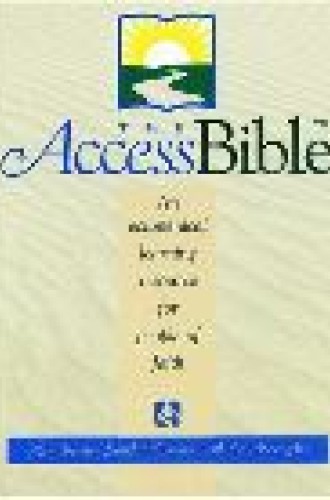Noted texts
While pastors and academics usually have many volumes of biblical commentary on their shelves, the average layperson gets his or her information from one or more of the study Bibles that have flooded the marketplace in the past two decades. These Bibles, typically targeted to a niche group—women, teens, African Americans, etc.—have begun to exercise a powerful influence on Christian communities. The placing of commentary on the same page as the scriptural text itself carries enormous ideological weight, requiring the reader to move between the text, which is authoritative, and the commentary, which is not, while holding these distinctions firmly in place.
With the exception of editions such as the New Oxford Annotated Bible, the HarperCollins Study Bible and the Oxford Study Bible, these offerings tend to ignore contemporary biblical research, since it often conflicts with readers’ views. Recently, however, several high-quality study Bibles conversant with current scholarship have been published—Bibles that by and large would interest mainline congregations.
The capstone of Abingdon’s New Interpreter’s Bible commentary series is the New Interpreter’s Study Bible, published under the capable leadership of Walter Harrelson (Vanderbilt University). One of the largest (and heaviest) study Bibles currently in print, it represents the finest ecumenical and interfaith biblical scholarship. It is a portable introductory course to both testaments and the apocrypha.
In many ways the volume is old school. It has no fancy graphics or eye-catching diagrams. The few essays in the back, though written by senior scholars of unquestioned excellence, address interpretive questions only in a cursory fashion and could have been omitted without detracting from the work’s overall quality. The commentary’s value is in the notes. Harrelson has two excellent strategies for dealing with “hot spots” in the text, the excursus and the special note.
The excursus is a familiar feature of many study Bibles, but the NISB contains an impressive number of them—almost 120, double the number in the other volumes reviewed here. In the excursuses, placed just below the crucial texts that have given rise to a particular discussion, many of the essential findings of modern scholarship are unpacked. They cover the full range of biblical themes, from “the image of God” in (Genesis) and “Zion in prophetic literature and the psalms” (in Isaiah) to “Lukan eschatology” and “household codes” (in Ephesians). Indexed in the front of the volume both by biblical book and title, they are easy for readers to find.
The most interesting aspect of the NISB, however, is the “special note,” which Harrelson describes as “designed to call particular attention to texts and ideas that have had unusual importance in the history of biblical interpretation,” as well as “to alert readers to exercise unusual care in their study and interpretation” of such texts. The note on Luke 13, for example, points out that the tradition that Israel murders its prophets, while it is alluded to by Jesus, has no textual basis whatsoever in the Old Testament. Similarly, the note between Galatians 3 and 4 explains that Paul’s comment on the law as a “curse” is misleading, and that Romans contains a more balanced passage on the subject.
Thus, the excursuses provide an introduction to the basics of academic biblical studies, while the special notes expose readers to some of the areas currently “in play” in the scholarly debate. These two features, coupled with the enormous volume of high-quality notes, make this a book that every pastor and professor will want in the hands of parishioners and students.
The Jewish Study Bible, using the Jewish Publication Society’s Tanakh translation, brings together the best Jewish scholarship in the English-speaking world in an exceptional volume of immense value to Jews and Christians alike. The editors make clear both that the Tanakh is complete in itself and is not a prelude to anything, including the New Testament, and that this particular study Bible is integrally connected to Jewish faith and life. Following the tripartite division of the Jewish canon, the editors introduce the Torah, Nevi’im (prophets) and Kethuvim (writings) with essays that place these canonical divisions within the context of critical scholarship.
The individual books are introduced and annotated by well-established scholars like Jon D. Levenson, Marvin Sweeney and Ziony Zevit, giving readers a rich collection of critical insights. The editors work with the double awareness both of the unsettled position of the academy on questions of historicity and the longstanding reading practices of the Jewish community—practices which do not require validation by Enlightenment truth claims. They aim to strike a balance between critical engagement and community requirements.
A number of extraordinary features make this study Bible a treasure. An excellent glossary defines many facets of Jewish life, including significant dates, ritual elements and interpreters. An exhaustive index covers all aspects of the notes and essays, a feature lacking in the other Bibles reviewed here. Regrettably, it has no concordance, but scholars and students will appreciate the inclusion of a chart listing all of the variances between chapter/verse systems in English and Hebrew. Also included is a listing of the weekly Sabbath readings, from which the idea of the Christian lectionary was derived. Easily the most valuable feature of this edition, however, is the 175 pages of essays at the back of the book, broadly divided into three categories: “Jewish Interpretation of the Bible,” “The Bible in Jewish Life and Thought” and “Backgrounds for Reading the Bible.” The ordering of these essays, which prioritizes the community’s reading strategies over the academy’s, demonstrates the editorial intention to interpret the scripture in a distinctively Jewish fashion.
Christian readers will find it interesting to read disputed texts from this Jewish perspective. The core text of Christian messianism, Isaiah 7:14, is a good example. The textual notes highlight the passage’s multiple ambiguities: Is the sign spoken of the pregnancy, the birth, the child’s name or the child’s diet? Is the sign to occur immediately, soon or years later? As ambiguous as the text may be, there is no ambiguity whatsoever in the notes. They state with absolute certainty that, though “ancient and medieval Christians” tried to connect this passage to the New Testament Mary, “all modern scholars” agree that the term translated “young woman” simply means a woman of marriageable age; it denotes nothing about her marital status or sexual experience. The notes thus assert the wrong-headedness of Christian interpretations, but carefully attribute such readings to generations long past.
The Access Bible, based on the New Revised Standard Version, is an “ecumenical learning resource for people of faith.” It represents “mainline” (“old line”?) scholarship and an approach that places critical study in the service of an open and informed church faith. It begins with three essays by David Petersen (Candler School of Theology), followed by an article on the canon by John Barton. Petersen reflects on the volume’s intention, considers what constitutes “Bible study” and provides an extended comment on method, with particular reference to genre analysis pivoting on the distinction between narrative and nonnarrative literature. The accent on genre analysis is especially important. In the current widespread misuse of the Bible in the church, a disregard for genre analysis leads people to ask texts to carry more freight than they can sustain. The book’s conclusion offers useful resources, including an extended glossary, a list of weights and measures, a concordance and a full set of maps.
The notes on particular texts are offered by some of the most established interpreters in the field. In addition to such senior scholars as Ronald Clements, John J. Collins, Ralph W. Klein and Kathleen M. O’Connor, contributors include rising scholars who are making important and venturesome contributions to the field. The rather sparse notes explain unusual words, ancient customs and particular literary and historical features (sometimes more extended treatment is given in sidebars). For the most part, they focus on historical-critical matters and do not venture into hermeneutical issues. Space is limited and one cannot do everything, though more hermeneutical attentiveness would have made the commentary stronger. The notes are adequate and helpful without being venturesome or in any way surprising.
Petersen’s introduction characterizes Bible study as here envisioned: “The disciplined and active reading of the Bible in order to gain new understandings about the biblical text or the reader’s own situation. . . . This way of thinking includes learning about ancient Israel or early Christianity as well as coming to a new understanding of one’s own condition.” Largely limiting itself to historical-critical issues, the volume does not go far into existential interpretive concerns. But good pastoral pedagogy can lead the church into the more complex zones of interpretation having to do with “one’s own condition.” The table is set, but serving the banquet will require pastoral work. But then, that is what we should expect from a resource “for people of faith,” meant to be used in ways that enhance the faith of the community.
NIV Spirit of the Reformation Study Bible, edited by Richard L. Pratt Jr. (Reformed Theological Seminary), in every way stands at the other end of the interpretive spectrum. This study Bible features a cadre of serious conservative evangelical scholars. The work is deeply committed to Reformed faith of the kind George Lindbeck refers to as “propositional theology.” The book’s notes, based on the New International Version, are extensive, indeed copious, and deal with every sort of question that might arise in the interpretive process. They are supported by a series of maps and charts, as well as a concordance.
Three features characterize the interpretive process here. Whereas in more liberal circles the historicity of the Bible is a complex and vexed question, here the text is taken at face value without any hermeneutic of suspicion or acknowledgment of any ideological tilt in the text. Second, the commentary is dogmatically clear and self-conscious, as the inclusion of a series of Reformed Confessions indicates. This presentation of doctrinal norms and standards signals that the scripture interpretation in the notes is situated in specific doctrinal frames of reference that concede nothing to the “acids of modernity” or to more recent hermeneutical tendencies.
This doctrinal intentionality is reinforced by a series of “theological articles” triggered by particular texts. With reference to Psalm 139, for example, the issue of divine omniscience is addressed with the question, “Does God know everything?” The answer is that “scripture declares that God’s eyes run everything. . . . In other words, he knows everything all the time. He knows the future no less than the past and the present, and possible events that never happen no less than the actual events that do.” It is clear that the book is designed as a teaching tool intended to connect classic Reformed theology with specific texts.
Finally, the notes regularly appeal to typology, so that the Book of Exodus, for example, “points to Christ.” The scapegoat in Leviticus 16 is a figure of Christ, and Christ is variously attested in Psalms and Proverbs. There are occasions when a more playful interpretation appears, though these are the exception to the general rule of dogmatic clarity. For example, the discussion of Isaiah 7:14 allows that alternative views of the text are held by some Christians.
This volume invites us to a Bible firmly placed in a specific confessional tradition, a strand of Calvinism. Together, the Access Bible and the NIV Spirit of the Reformation Study Bible demonstrate the primary tension that now inhabits and bewitches the American church. Both presentations proceed with great authority—one critical, the other confessional. It might be useful for readers to ponder how to negotiate between these nonnegotiable perspectives.
Timothy F. Simpson is adjunct professor of religion at the University of North Florida and editor of Political Theology. Walter Brueggemann is emeritus professor of Old Testament at Columbia Theological Seminary.









